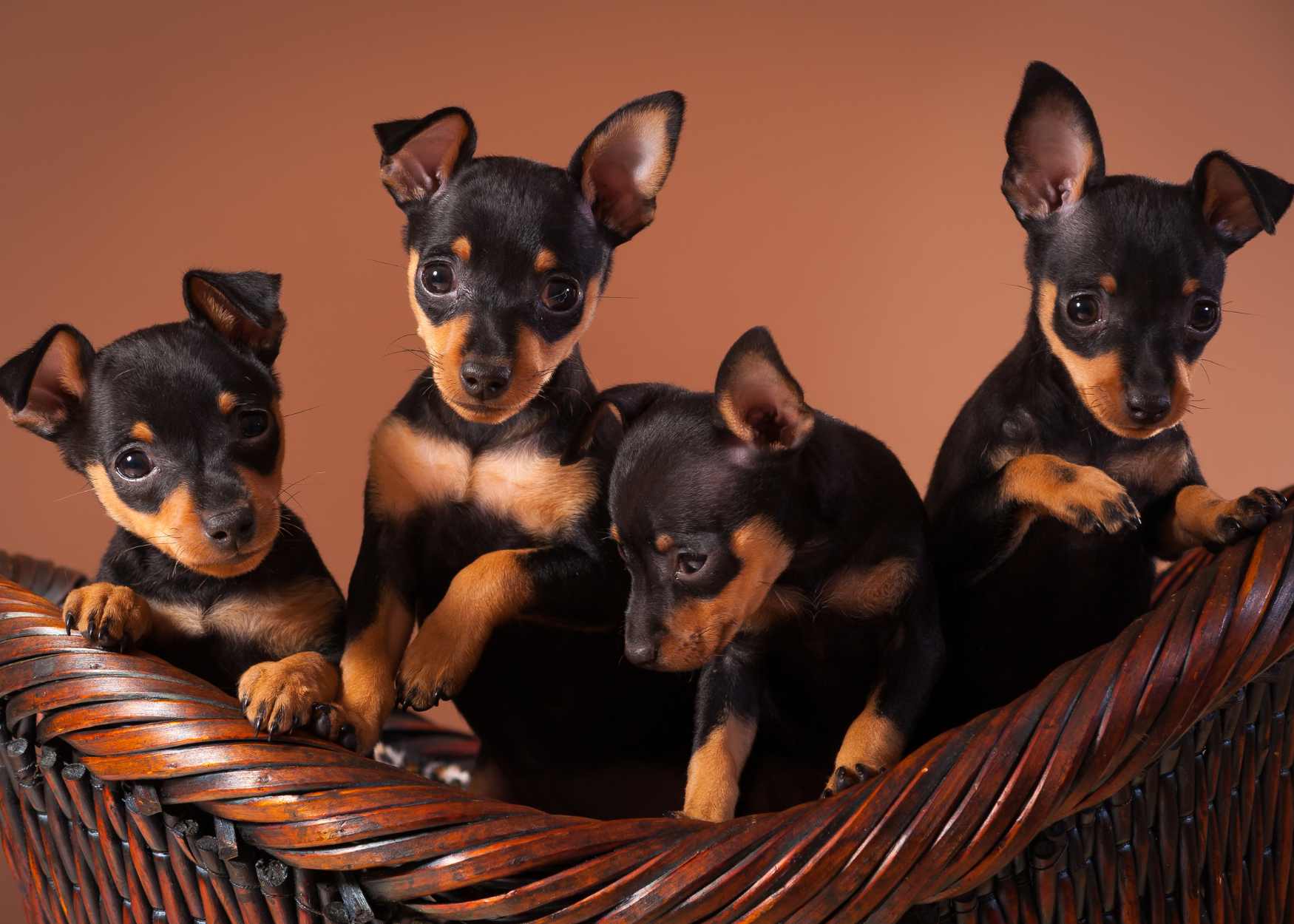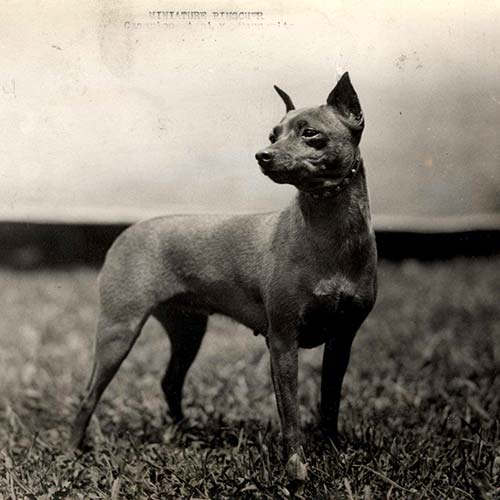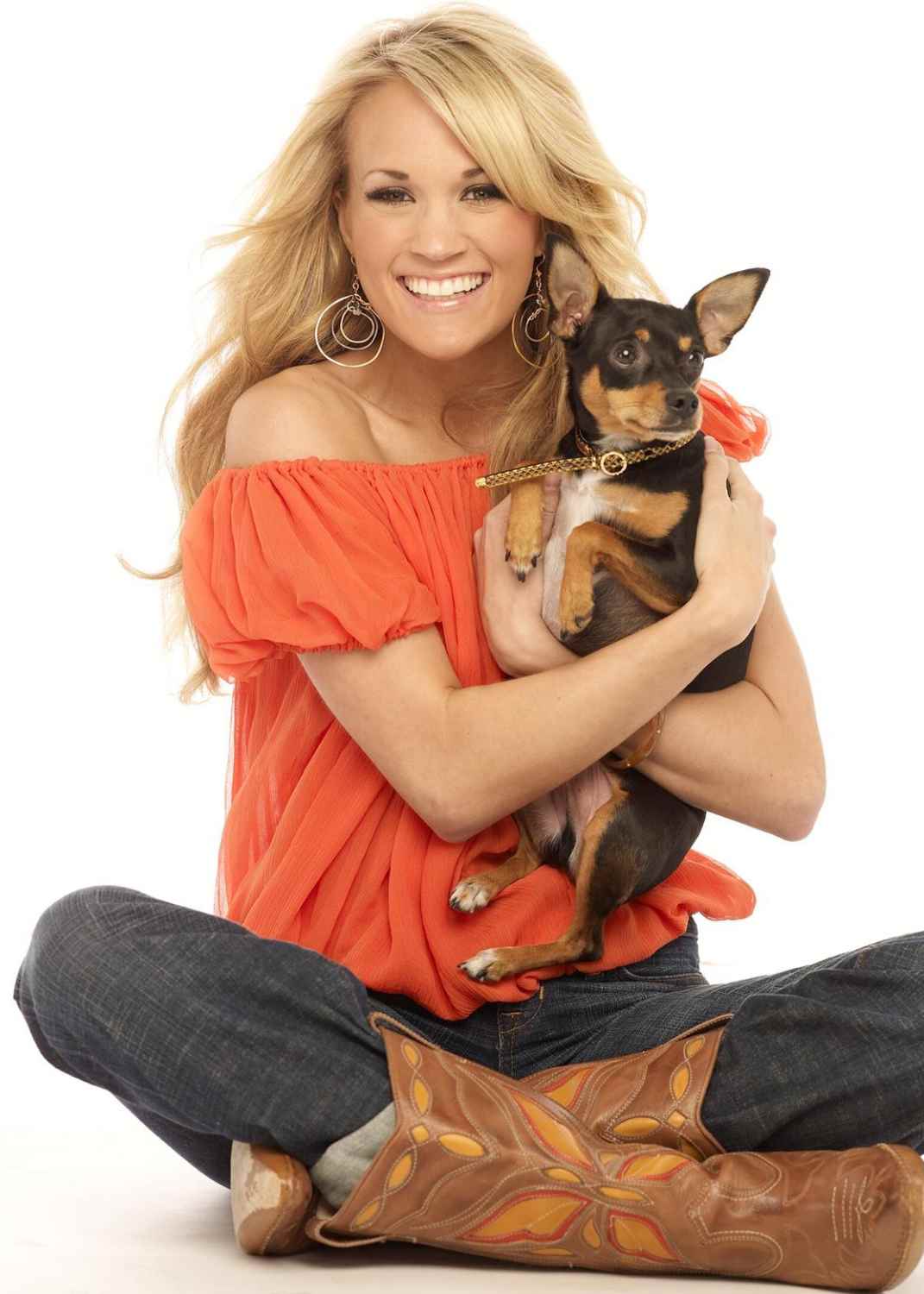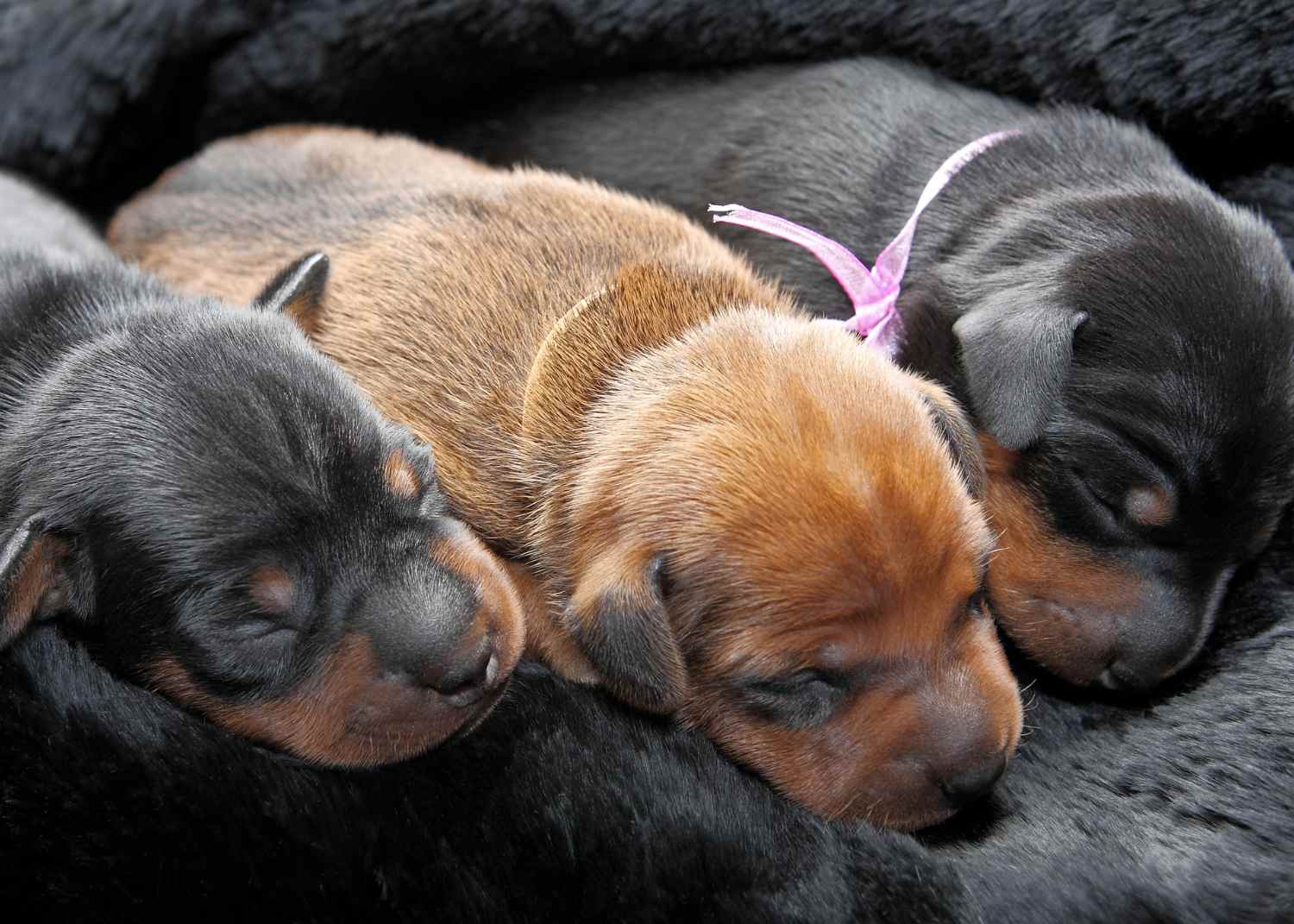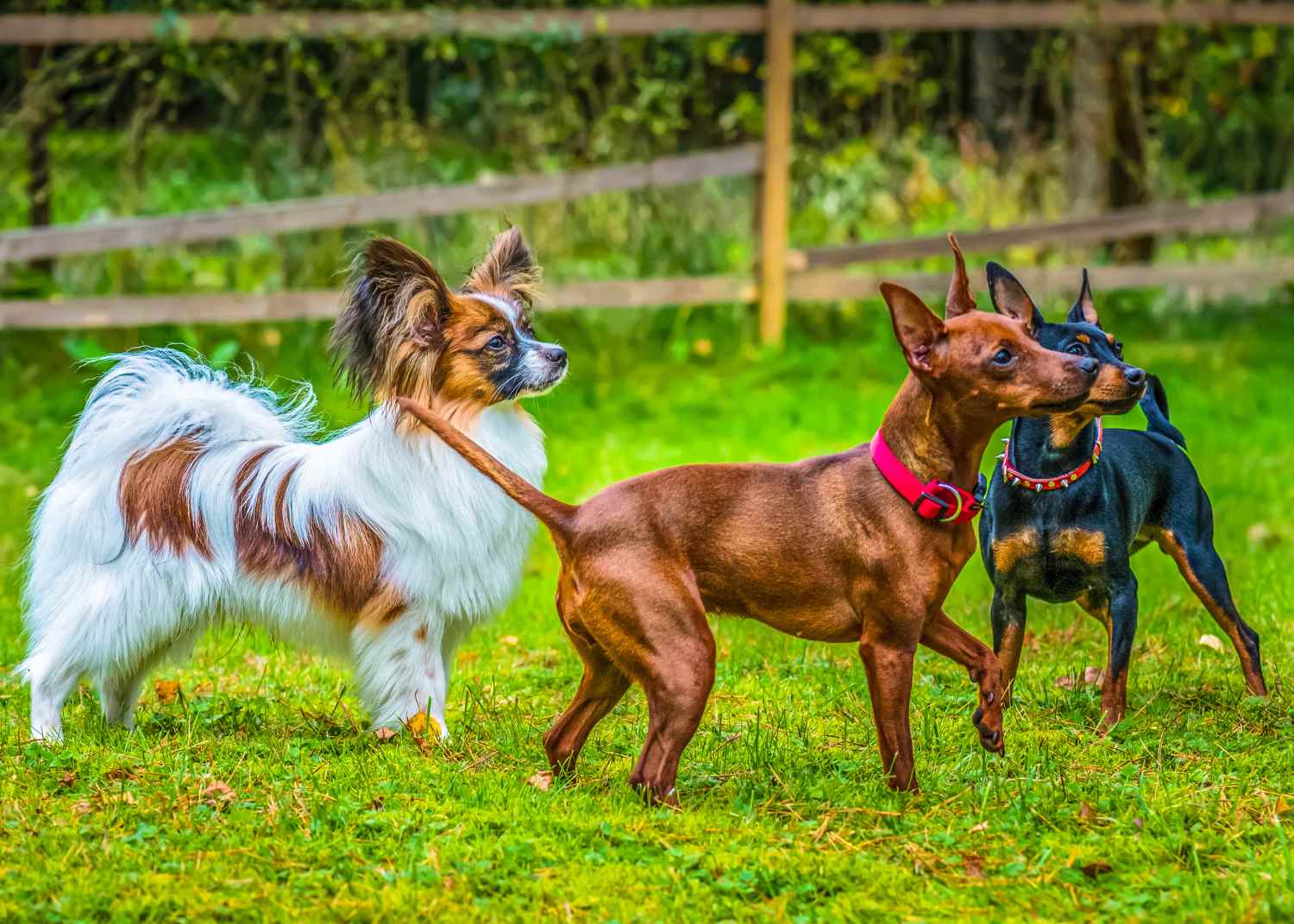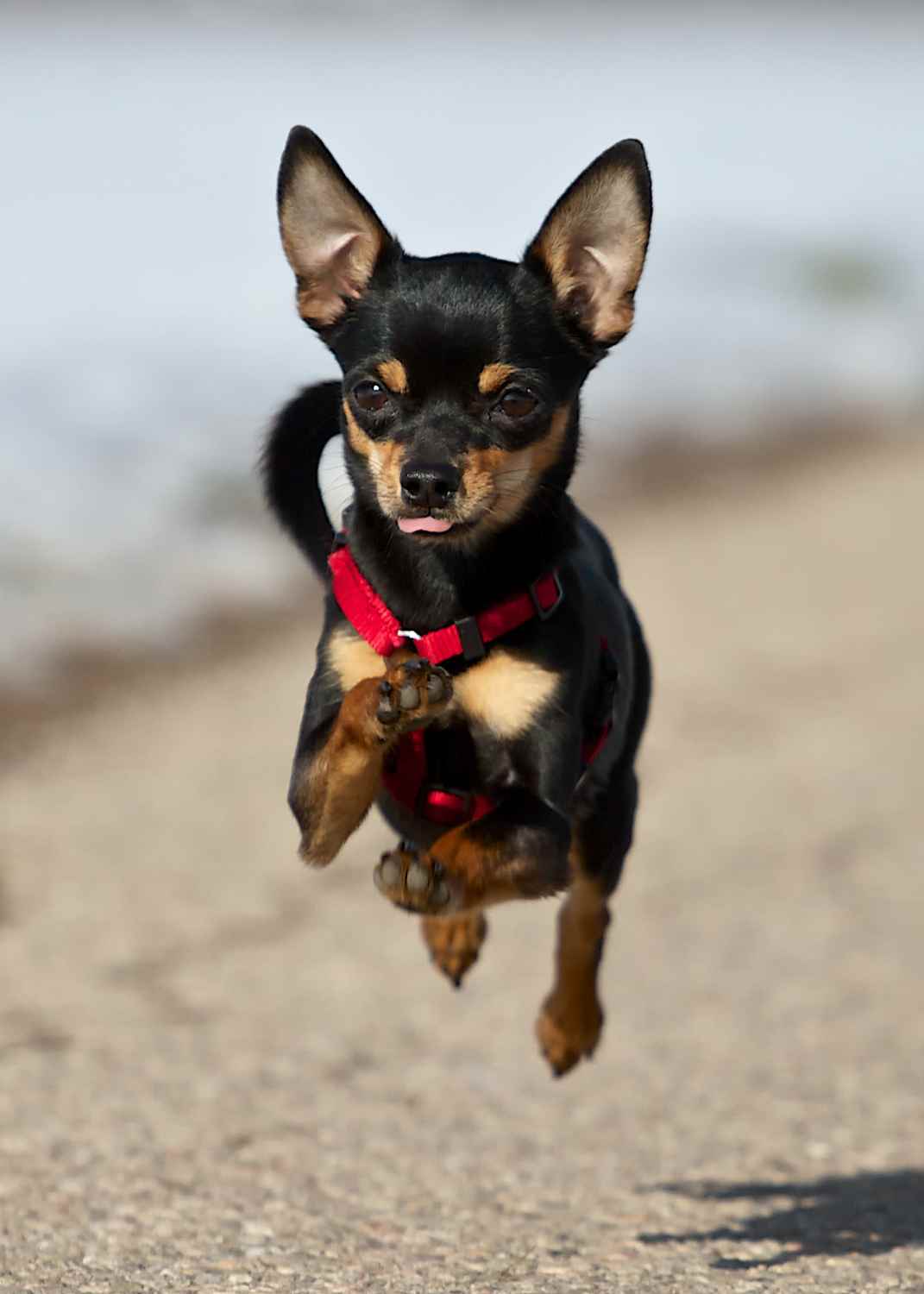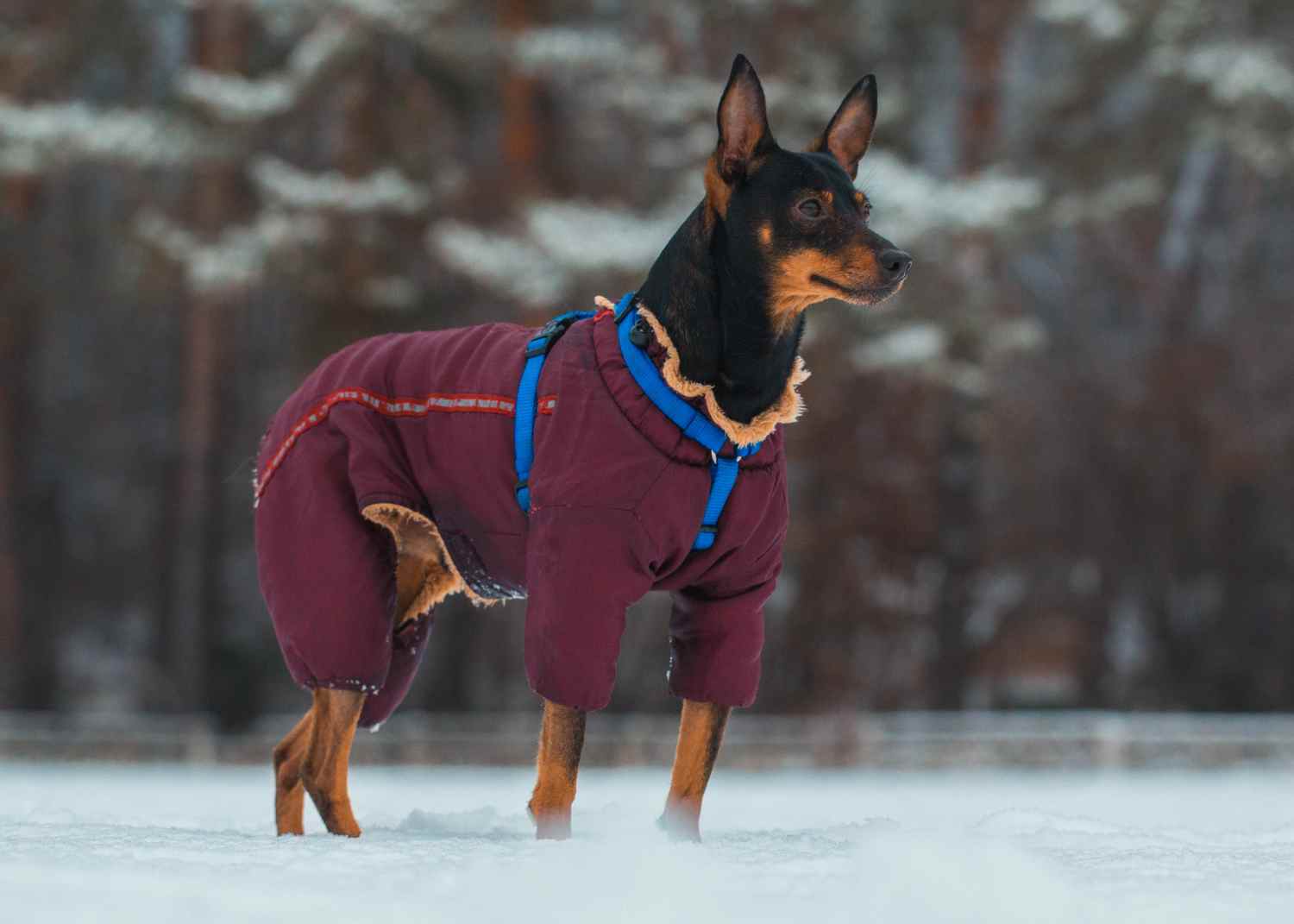You’re at the dog park about to enter the Small Dog section and see another dog owner come up to you. “Oh, how cute! A tiny Doberman Pinscher!” they say. “Actually, it’s a Miniature Pinscher! We call them ‘Min Pins’ sometimes for short. They’re not related to Dobermans, but I can see why you’d think that.”
You then go on to explain this little dog is called the “King of Toys,” a fitting name for a courageous, loyal, and alert tiny canine with non-stop energy and a spirited personality.
If you’re looking for a fearless, fun-loving, proud tiny toy dog, a Miniature Pinscher would check all the boxes. See what it’s like to be a Miniature Pinscher puppy owner with our ultimate guide to see if this puppy is right for you.
The History and Origin of Miniature Pinschers
Miniature Pinschers hail from Germany and were established around 200 years ago according to documentation. However, their exact origin is not known. They may have been a mix of the Shorthaired German Pinscher, Italian Greyhounds, and Dachshunds. Due to their similar rust-and-black features, docked tails, cropped ears, and similar-sounding names (“Pinscher” means “terrier” in German), some people assume they are miniature versions of the Doberman Pinscher. In reality, they are completely separate breeds.
A Miniature Pinscher’s purpose was primarily that of a rat hunter, utilized to keep barns, storerooms, and homes free of vermin. Due to their size and bold personality, they were able to fit into tiny spaces where rats could hide where humans could not reach them.
Min Pins were called “The King of Toys” due to their popularity with aristocracy and the working class alike. Miniature Pinschers gained attention for their agility, intelligence, and fearless nature. They were also prized as watchdogs due to their keen alertness and vocal nature. By the 19th century, the breed's distinct characteristics were established, and they became popular among European nobility as companions and show dogs.
Miniature Pinschers first arrived in America in the late 19th century, but their popularity surged after World War I when soldiers returning from Europe brought them home as souvenirs. The American Kennel Club officially recognized the breed in 1929.
The popularity of Miniature Pinschers
Today, Miniature Pinschers continue to captivate dog enthusiasts with their bold personalities and striking appearance. Miniature Pinschers are not as common as other Mini breeds like Mini Goldendoodles or Miniature Dachshunds, but that doesn’t take away from their charm. While they may not be as widespread as some other breeds, they maintain a devoted following among owners who appreciate their energetic demeanor and compact size. People just haven’t discovered them yet! According to the AKC’s list of Most Popular Dog Breeds of 2022, Miniature Pinschers ranked 79th between Irish Setters and Russell Terriers.
Social media platforms showcase the joy of living with these tiny, feisty comedians. Celebrities also know how wonderful it is to be a Miniature Pinscher owner, including Joey Fatone of NSYNC, Michelle Jones of the MCU, Paris Hilton, and Carrie Underwood. She’s quoted as saying, “Nobody’s going to tell me that my dog doesn’t love me. That’s crazy talk.
Physical Characteristics of Miniature Pinscher Puppies
Miniature Pinschers are known for their elegant and graceful appearance, with a proud posture and alert expression. While Miniature Pinschers may look delicate, their compact, wedge-shaped physique is sturdy for their size. As a member of the Toy group, Miniature Pinscher puppies will only grow to be 8-10 pounds and stand 10-12.5 inches tall, a perfect size to cuddle on your lap.
A Min Pin’s head is proportionate to its body with a strong, straight muzzle. They have dark, almond-shaped eyes and high-set ears that are often cropped to stand upright. The tail is usually docked to a medium length and carried high. Miniature Pinschers step with a prancing, lively gait, giving them quite an air of importance and confidence.
Their sleek, short glossy coats lie close to the body. Common coat colors include solid red, stag red (a mix of red and black hairs), black and rust, or chocolate and rust. Miniature Pinschers may also have tan markings on their face, chest, legs, and paws.
With all the variations of this tiny dog, there is a Miniature Pinscher for everyone to admire.
What’s the Personality Like of a Miniature Pinscher Puppy?
Miniature Pinschers have unique quirks and qualities that make them stand out among toy breeds. Here are some fun facts about their personality that Miniature Pinscher puppy owners would tell you.
Active & lively
Miniature Pinschers are lively and love to play games. If you don’t entertain them, they’ll get your attention one way or another! Purchase non-toxic toys made for small mouths, and provide interactive games like wobbly balls and puzzles to keep their brains sharp.
Confident & fearless
Miniature Pinscher puppies are extremely tiny, but they’re feisty! And don’t tell a full-grown Min Pin they aren’t a big dog, either! They are fearless to a fault and will tell those birds outside where to go with gusto. The confidence in these little dogs is astounding, and they’ll make you laugh with their bold shenanigans.
Small canine friends are best
Miniature Pinschers get along well with other dogs, especially when socialized from a young age and continued exposure to canine friends. However, if you already live with a larger high-energy dog, a Miniature Pinscher may not be quite the best fit – literally. Because of its small size as a toy breed, Miniature Pinschers do best with other small-to-medium-sized dogs due to the safety issue of possibly getting hurt while playing with bigger, more energetic dogs.
Excellent companions
Miniature Pinschers are extremely adaptable and versatile companion dogs for anyone, from singles to families to the elderly. Their lovey-dovey nature is perfect for a lap dog that loves to cuddle up and be near their owners. They’re even portable enough to take along in a fashionable carrier to a dog-friendly brunch.
Loving therapy dogs
Because of their size and affinity for snuggles, Miniature Pinschers are excellent emotional support therapy dogs. From keeping seniors company to providing comfort, these portable little dogs cuddle on laps and provide plenty of affection and love to those in need.
Curious creatures
Miniature Pinschers are known for their intense curiosity. They tend to explore all corners of their environment, so be prepared for a little four-legged snoop! They may find themselves in hilarious yet precarious situations when left unattended. Think of how you would act around a toddler, and that’s the level of watchfulness you’ll need with a curious Miniature Pinscher puppy. Crate training your Miniature Pinscher is a great way to provide a safe space so they do not get themselves into naughty trouble.
Great with older children
Min Pins are great around children, matching their high energy levels and making fun playmates. However, young children who do not understand how to interact properly with a dog so small can quickly turn into an unfortunate situation due to rough play with such a tiny dog. Always supervise your Miniature Pinscher puppy around children for an incident-free time.
Fine little watchdogs
A sharp bark from a Min Pin lets you know it assumes it’s as big as a Cane Corso Mastiff protecting the home from intruders. While no one would expect a Miniature Pinscher to take down a robber, they make excellent watchdogs, always alert for anything amiss. Early socialization will help mitigate their nature to bark at unnecessary things, as they are known to bark excessively if not trained well.
Training a Miniature Pinscher
Some people think that small dogs don’t necessarily need a lot of training because they’re so small. However, nothing could be farther from the truth! These dogs can become tiny tyrants and rule over you if you do not establish a routine and order through training.
Miniature Pinschers should begin one of several popular training methods for puppies to learn basic commands and ensure good canine behavior starting Day One. Patience and consistency are the keys to maintaining a steady composure and getting good results. After they master the basics, Miniature Pinscher puppies should continue training, as positive reinforcement is effective in keeping skills fresh. A rewards-based training program is best, as Miniature Pinschers can be sensitive or willful.
Min Pins are intelligent, but with their cleverness comes stubbornness. Housetraining can be challenging, but a regular schedule of going outside and crate training helps due to them not wanting to soil where they sleep. Let them know who is in charge without being forceful so they know not to walk all over you with those dainty little paws. Above all, having a patient, forgiving attitude will serve you well as you train your Miniature Pinscher.
Caring For Your Miniature Pinscher
While all dogs need love and care, Miniature Pinschers have unique needs specific to their breed. Learn how to groom and care for your Miniature Pinscher so you can enjoy a long lifespan of 12-16 years.
Grooming your Miniature Pinscher
Unlike other breeds requiring daily brushing and regular trimming or shaving, Miniature Pinschers do not have many grooming requirements and are low-maintenance dogs to groom. Min Pins have a short, smooth, glossy coat that sheds short hairs. You could groom your dog at home since they just need a thorough brushing about once a week and a bath every 1-2 months or so depending on odor. Keep their nails trimmed and check for skin, eye, or ear irritations.
Keeping your Min Pin safe and healthy
Miniature Pinschers can lead a wonderful, fulfilling life when you take preventative measures for their well-being. As mentioned before, training and socializing your Miniature Pinscher will help them to be good canine citizens. Supervise them around large dogs and children because they are delicate, even with their larger-than-life attitudes.
Be careful with them in extreme weather conditions, such as too much heat or cold. They will need a coat or sweater due to their lack of body fat in the colder months. Miniature Pinscher owners love selecting a wardrobe, so be sure not to go overboard when your dog owns more fashionable clothing and accessories than you do!
Miniature Pinschers are known as the "Houdini of the dog world" thanks to their uncanny ability to squeeze through small spaces, a trait that was handy for catching rats but not so much in your backyard. Ensuring the safety of your Miniature Pinscher requires meticulous attention to your yard and fencing. Conduct a thorough inspection, addressing any holes or openings that could allow escape – if your hand can fit through, so can your Min Pin. Additionally, reinforce all doors, windows, and screens to prevent any potential escapes.
Establishing a partnership
You can’t care for your Miniature Pinscher alone. You’ll need to establish a relationship with a licensed veterinarian when you adopt your Miniature Pinscher puppy. Keeping your Min Pin healthy and socially ready requires regular vet visits. Your new vet will ensure your pup is up-to-date on core puppy vaccinations and recommend a wellness checklist for puppies to maintain between visits. Expect monthly check-ups until around 16 weeks, possibly including a spay or neuter appointment. Afterward, it's typically an annual visit for well checks and addressing any unexpected issues or illnesses.
Dental care for small dogs needs to be a priority for a Miniature Pinscher. They have the same number of teeth as any other dog except contained in a tiny mouth. It’s not unusual to experience dental issues such as crowded, broken, or abscessed teeth and jaw issues. However, with regular dental care and hygiene, you can prevent painful dental issues in your Miniature Pinscher.
Common health issues
While Miniature Pinschers are a relatively healthy, robust dog breed, they are prone to certain health conditions. Patellar luxations, hypothyroidism, obesity, and progressive retinal atrophy can be common health concerns. One issue common in toy breeds is Legg-Calve-Perthes disease, a degenerative condition affecting the hip joint, leading to deterioration and collapse of the femoral head. It will appear around 4-6 months but has a good prognosis with surgery.
Adopt a Miniature Pinscher Puppy From Pawrade
If you've decided a Miniature Pinscher puppy is the right fit for you, consider turning to Pawrade for a hassle-free way to find your perfect furry companion. We're committed to connecting loving families with puppies in need of homes, ensuring ethical breeding practices while prioritizing the health of our puppies.
With Pawrade, you can confidently browse Miniature Pinscher puppies for sale, knowing that all breeders on our platform are genuine and trustworthy. Say goodbye to endless searches for "Miniature Pinscher puppies for sale near me" – Pawrade simplifies your journey and helps you start a new chapter with your ideal companion. Contact us anytime to learn more about our process and begin your puppy adoption experience.
